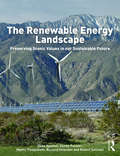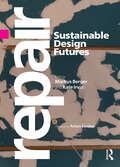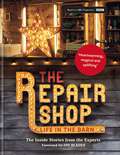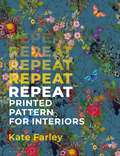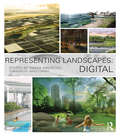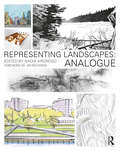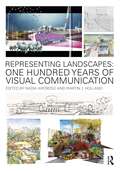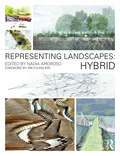- Table View
- List View
Rendering in SketchUp: From Modeling to Presentation for Architecture, Landscape Architecture, and Interior Design
by Daniel TalThe sure way for design professionals to learn SketchUp modeling and rendering techniques Rendering In SketchUp provides instructions for creating 3D photoreal graphics for SketchUp models using integrated rendering programs. The book serves as a beginner rendering manual and reference guide to further develop rendering skills. With an emphasis on step-by-step process, SketchUp users learn a universal approach to rendering varied SketchUp projects, including architecture, interiors, and site design models. The book focuses on tasks and principles at the core of photorealistic rendering, including: Rendering process: Learn a step-by-step process focused on workflow within SketchUp’s familiar workspace. Universal method: Understand how the process can be used to work with a variety of different integrated rendering programs, including Shaderlight, SU Podium and Twilight Render**. These programs are easy to learn and function in SketchUp. // // > Textures and materials: Discover how to obtain, apply and edit texture images representing surfaces. Component details: Learn how to acquire and organize model details to allow for rich, expressive settings while maintaining computer and SketchUp performance. Exterior and simulated lighting: Learn to set exterior lighting with the SketchUp’s Shadow menu or illuminate a scene with simulated lights, lamps, and bulbs. Render settings: Use specific settings for various rendering programs to quickly set texture character, image quality, and graphic output. Computer specifications: Find out how computers produce renders and the type of computer hardware required to streamline the process. Photoshop post-processing: Learn how to further refine rendered images in Photoshop. **Free online chapters: The book reviews specific settings for SketchUp and the rendering plug-in Shaderlight. Given the ever-changing nature of technology, free, online accompanying chapters detail settings for additional integrated rendering programs including SU Podium, Twilight Render, and more.
Rendering in SketchUp: From Modeling to Presentation for Architecture, Landscape Architecture, and Interior Design
by Daniel TalThe sure way for design professionals to learn SketchUp modeling and rendering techniques Rendering In SketchUp provides instructions for creating 3D photoreal graphics for SketchUp models using integrated rendering programs. The book serves as a beginner rendering manual and reference guide to further develop rendering skills. With an emphasis on step-by-step process, SketchUp users learn a universal approach to rendering varied SketchUp projects, including architecture, interiors, and site design models. The book focuses on tasks and principles at the core of photorealistic rendering, including: Rendering process: Learn a step-by-step process focused on workflow within SketchUp’s familiar workspace. Universal method: Understand how the process can be used to work with a variety of different integrated rendering programs, including Shaderlight, SU Podium and Twilight Render**. These programs are easy to learn and function in SketchUp. // // > Textures and materials: Discover how to obtain, apply and edit texture images representing surfaces. Component details: Learn how to acquire and organize model details to allow for rich, expressive settings while maintaining computer and SketchUp performance. Exterior and simulated lighting: Learn to set exterior lighting with the SketchUp’s Shadow menu or illuminate a scene with simulated lights, lamps, and bulbs. Render settings: Use specific settings for various rendering programs to quickly set texture character, image quality, and graphic output. Computer specifications: Find out how computers produce renders and the type of computer hardware required to streamline the process. Photoshop post-processing: Learn how to further refine rendered images in Photoshop. **Free online chapters: The book reviews specific settings for SketchUp and the rendering plug-in Shaderlight. Given the ever-changing nature of technology, free, online accompanying chapters detail settings for additional integrated rendering programs including SU Podium, Twilight Render, and more.
ReNew Town: Adaptive Urbanism and the Low Carbon Community (Routledge Contemporary Asia Ser.)
by Andrew Scott Eran Ben-JosephReNew Town puts forth an innovative vision of performative design and planning for low-carbon sustainable development, and illustrates practicable strategies for balancing environmental systems with urban infrastructure and new housing prototypes. To date, much of the discourse on the design of sustainable communities and ‘eco-cities’ has been premised on using previously undeveloped land. In contrast, this book and the project it showcases focus on the retrofitting and adaptation of an existing environment – a more common problem, given the extent of the world’s already-built infrastructure. Employing a ‘research through design’ model of inquiry, the book focuses on large-scale housing developments – especially those built around the world between the 1960s and the early 1980s – with the aim of understanding how best to reinvent them. At the center of the book is Tama New Town, a planned community outside Tokyo that faces a range of challenges, such as an aging population, the deterioration of homes and buildings, and economic stagnation. The book begins by outlining a series of principles that structure the ecological and energy goals for the community. It then develops prototypical solutions for designing, building and retrofitting neighborhoods. The intent is that these prototypes could be applied to similar urban conditions around the world. ReNew Town is the product of a collaborative design research project at the Massachusetts Institute of Technology (MIT) School of Architecture and Planning, and Japan’s Sekisui House LTD.
ReNew Town: Adaptive Urbanism and the Low Carbon Community
by Andrew Scott Eran Ben-JosephReNew Town puts forth an innovative vision of performative design and planning for low-carbon sustainable development, and illustrates practicable strategies for balancing environmental systems with urban infrastructure and new housing prototypes. To date, much of the discourse on the design of sustainable communities and ‘eco-cities’ has been premised on using previously undeveloped land. In contrast, this book and the project it showcases focus on the retrofitting and adaptation of an existing environment – a more common problem, given the extent of the world’s already-built infrastructure. Employing a ‘research through design’ model of inquiry, the book focuses on large-scale housing developments – especially those built around the world between the 1960s and the early 1980s – with the aim of understanding how best to reinvent them. At the center of the book is Tama New Town, a planned community outside Tokyo that faces a range of challenges, such as an aging population, the deterioration of homes and buildings, and economic stagnation. The book begins by outlining a series of principles that structure the ecological and energy goals for the community. It then develops prototypical solutions for designing, building and retrofitting neighborhoods. The intent is that these prototypes could be applied to similar urban conditions around the world. ReNew Town is the product of a collaborative design research project at the Massachusetts Institute of Technology (MIT) School of Architecture and Planning, and Japan’s Sekisui House LTD.
The Renewable Energy Landscape: Preserving Scenic Values in our Sustainable Future
by Dean Apostol James Palmer Martin Pasqualetti Richard Smardon Robert SullivanWinner of the 2017 EDRA Great Places Award (Research Category) Winner of the 2017 VT ASLA Chapter Award of Excellence (Communications Category) The Renewable Energy Landscape is a definitive guide to understanding, assessing, avoiding, and minimizing scenic impacts as we transition to a more renewable energy future. It focuses attention, for the first time, on the unique challenges solar, wind, and geothermal energy will create for landscape protection, planning, design, and management. Topics addressed include: Policies aimed at managing scenic impacts from renewable energy development and their social acceptance within North America, Europe and Australia Visual characteristics of energy facilities, including the design and planning techniques for avoiding or mitigating impacts or improving visual fit Methods of assessing visual impacts or energy projects and the best practices for creating and using visual simulations Policy recommendations for political and regulatory bodies. A comprehensive and practical book, The Renewable Energy Landscape is an essential resource for those engaged in planning, designing, or regulating the impacts of these new, critical energy sources, as well as a resource for communities that may be facing the prospect of development in their local landscape.
The Renewable Energy Landscape: Preserving Scenic Values in our Sustainable Future
by Dean Apostol James Palmer Martin Pasqualetti Richard Smardon Robert SullivanWinner of the 2017 EDRA Great Places Award (Research Category) Winner of the 2017 VT ASLA Chapter Award of Excellence (Communications Category) The Renewable Energy Landscape is a definitive guide to understanding, assessing, avoiding, and minimizing scenic impacts as we transition to a more renewable energy future. It focuses attention, for the first time, on the unique challenges solar, wind, and geothermal energy will create for landscape protection, planning, design, and management. Topics addressed include: Policies aimed at managing scenic impacts from renewable energy development and their social acceptance within North America, Europe and Australia Visual characteristics of energy facilities, including the design and planning techniques for avoiding or mitigating impacts or improving visual fit Methods of assessing visual impacts or energy projects and the best practices for creating and using visual simulations Policy recommendations for political and regulatory bodies. A comprehensive and practical book, The Renewable Energy Landscape is an essential resource for those engaged in planning, designing, or regulating the impacts of these new, critical energy sources, as well as a resource for communities that may be facing the prospect of development in their local landscape.
Repair: Sustainable Design Futures
by Markus Berger Kate IrvinA collection of timely new scholarship, Repair: Sustainable Design Futures investigates repair as a contemporary expression of empowerment, agency, and resistance to our unmaking of the world and the environment. Repair is an act, metaphor, and foundation for opening up a dialogue about design’s role in proposing radically different social, environmental, and economic futures. Thematically expansive and richly illustrated, with over 125 visuals, this volume features an international, interdisciplinary group of contributors from across the design spectrum whose voices and artwork speak to how we might address our broken social and physical worlds. Organized around reparative thinking and practices, the book includes 30 long and short chapters, photo essays, and interviews that focus on multiple responses to fractured systems, relationships, cities, architecture, objects, and more. Repair will encourage students, academics, researchers, and practitioners in art, design and architecture practice and theory, cultural studies, environment and sustainability, to discuss, engage, and rethink the act of repair and its impact on our society and environment.
Repair: Sustainable Design Futures
by Markus Berger Kate IrvinA collection of timely new scholarship, Repair: Sustainable Design Futures investigates repair as a contemporary expression of empowerment, agency, and resistance to our unmaking of the world and the environment. Repair is an act, metaphor, and foundation for opening up a dialogue about design’s role in proposing radically different social, environmental, and economic futures. Thematically expansive and richly illustrated, with over 125 visuals, this volume features an international, interdisciplinary group of contributors from across the design spectrum whose voices and artwork speak to how we might address our broken social and physical worlds. Organized around reparative thinking and practices, the book includes 30 long and short chapters, photo essays, and interviews that focus on multiple responses to fractured systems, relationships, cities, architecture, objects, and more. Repair will encourage students, academics, researchers, and practitioners in art, design and architecture practice and theory, cultural studies, environment and sustainability, to discuss, engage, and rethink the act of repair and its impact on our society and environment.
The Repair Shop: A Make Do and Mend Handbook
by Karen FarringtonHow do you replenish the stuffing in your favourite sofa seat or your child’s beloved, tatty teddy bear? How do you remove a water mark left on your wooden table? What’s the best way to prevent your leather from cracking? We all have items in our homes that sit about in a state of disrepair while we mull over how to fix them but never actually get round to it. Direct from the Repair Shop's 'Workshop of Dreams', this one-stop practical guide will help you care for those aging treasures and heirlooms around your house, stashed in the attic, or gathering dust in the garage.From furniture and toys to ceramics and clothing, the Repair Shop experts will give you their tips and advice on the art of restoring and conserving everyday items, so you can give new life to your most prized possessions. With clear step-by-step instructions and simple illustrations, find out how to clean, carry and maintain the articles that mean most to you, to safeguard your sentimental legacy for generations to come.
The Repair Shop: LIFE IN THE BARN: The Inside Stories from the Experts: THE LATEST BOOK
by Elizabeth Wilhide Jayne Dowle'Heartwarming, magical and uplifting'In today's throwaway culture, there's a counter movement growing that urges us to 'make do and mend'. The BBC's BAFTA Award winning The Repair Shop has brought this waste-conscious message to an even wider audience, with its regular viewing figures of 7 million in the UK alone, cementing itself as a classic series in the vein of Antiques Roadshow.This new book concentrates on the show's much-loved experts, including woodworker and furniture restorer Will Kirk, clock restorer Steve Fletcher, metalworker Dominic Chinea, silversmith Brenton West, leatherworker Suzie Fletcher, upholsterer Sonnaz Nooranvary, and seamstresses Julie Tatchell & Amanda Middleditch - aka The Teddy Bear Ladies. Each of the experts shares their own stories and their repairs, capturing in the process the magic and ethos of the barn. Includes quotations and Q & As from the experts as well as Jay Blades on some unique restoration collaborations.With the focus on the experts themselves, readers will feel as though they're stepping straight into the 'workshop of dreams' and experiencing first hand the magic of the barn.
The Repair Shop: Skills, stories and heartwarming restorations: THE LATEST BOOK
by Elizabeth Wilhide Jayne DowleThe Repair Shop - the Bafta-award-winning series with regular viewing figures of 7 million in the UK alone - has cemented itself as a BBC classic. Enter a workshop filled with expert craftspeople as they bring loved pieces of family history and the memories they hold back to life.Each expert explains their craft, the reason they love it so much and how they go about restoring and reviving your precious objects, from a Ukrainian suitcase to a matchstick clock, using crafts as varied as leatherwork, woodwork, metalwork, art and ceramic restoration.
The Repair Shop: Tales from the Workshop of Dreams
by Karen FarringtonEvery object tells a story...We all have treasures hidden away in the attic, well-loved and well-worn belongings that have been passed down from generation to generation. They may be damaged or no longer working, but we can't bear to part with them. The expert craftspeople of hit BBC series The Repair Shop are dedicated to restoring and conserving these heirlooms. They know that the true worth of these possessions doesn't lie in their monetary value, but in the memories they hold and the stories they tell. In this fascinating book, you'll step inside The Repair Shop's Workshop of Dreams to explore some of the most moving family stories from the hit BBC series. From a glamorous sequinned dress that belonged to a popular travelling circus performer to a pump organ that was brought from Jamaica by a member of the Windrush generation, each family item is brought vividly to life - and lovingly restored by the team of Repair Shop experts who also contribute to these expanded stories. With a foreword by Jay Blades, Tales from the Workshop of Dreams is a heartfelt love letter to our collective past, and a fascinating slice of social history.This book features items fixed by Repair Shop experts Steve Fletcher, Will Kirk, Lucia Scalisi, Suzie Fletcher, Kirsten Ramsay, Dominic Chinea, Brenton West, Tim Gunn, Sara Dennis, Chris Shaw, Matt Nickels, Amanda Middleditch and Julie Tatchell. With great care and attention to detail, the Repair Shop team resurrect priceless pieces of family history and breathe new life into the stories they hold.
Repeat Printed Pattern for Interiors
by Kate FarleyRepeating patterns can soothe or energize us, bringing joy and harmony to everyday life. Repeat Printed Pattern for Interiors explores the power repeat patterns hold over us and what goes into creating original, effective printed designs. Beginning with the history of patterns in interior design, Kate Farley uncovers lessons from the work of Owen Jones, William Morris, Collier Campbell and Josef Frank.There are also interviews with some of the best contemporary pattern designers working today: Angie Lewin, Deborah Bowness, Eley Kishimoto, Emma J. Shipley, Galbraith & Paul, Neisha Crosland, Orla Kiely OBE, Sarah Campbell and Timorous Beasties. Each interview covers the designer's practice and ethos and includes a deconstruction of one design, with discussion of initial sketches, details of design development, manufacturing insights and images of final products.Covering hand-drawn techniques through to digital manipulation, you'll also be guided through the implications of visual language, colour statements, manufacturing considerations and commercial interior contexts to prepare you to jump in and start creating your own unique patterns.
Repeat Printed Pattern for Interiors
by Kate FarleyRepeating patterns can soothe or energize us, bringing joy and harmony to everyday life. Repeat Printed Pattern for Interiors explores the power repeat patterns hold over us and what goes into creating original, effective printed designs. Beginning with the history of patterns in interior design, Kate Farley uncovers lessons from the work of Owen Jones, William Morris, Collier Campbell and Josef Frank.There are also interviews with some of the best contemporary pattern designers working today: Angie Lewin, Deborah Bowness, Eley Kishimoto, Emma J. Shipley, Galbraith & Paul, Neisha Crosland, Orla Kiely OBE, Sarah Campbell and Timorous Beasties. Each interview covers the designer's practice and ethos and includes a deconstruction of one design, with discussion of initial sketches, details of design development, manufacturing insights and images of final products.Covering hand-drawn techniques through to digital manipulation, you'll also be guided through the implications of visual language, colour statements, manufacturing considerations and commercial interior contexts to prepare you to jump in and start creating your own unique patterns.
Representing Landscape Architecture
by Marc TreibRepresenting Landscape Architecture offers a broad investigation of how the designed landscape is and has been represented: for design study, for criticism and even for its realization. It has been said that we can only realize what we can imagine. But in order to realize we must convey ideas to others as well as to ourselves. Representation is by no means neutral and the process of communication, the process by which the imagination takes its first form, itself necessarily limits the range of our design possibilities. Computers further remove from cognitive processes and raise new questions about methods and limits. Written by a team of renowned practitioners and academics, this book is the best available reference to date on the many dimensions of landscape representation.
Representing Landscape Architecture
by Marc TreibRepresenting Landscape Architecture offers a broad investigation of how the designed landscape is and has been represented: for design study, for criticism and even for its realization. It has been said that we can only realize what we can imagine. But in order to realize we must convey ideas to others as well as to ourselves. Representation is by no means neutral and the process of communication, the process by which the imagination takes its first form, itself necessarily limits the range of our design possibilities. Computers further remove from cognitive processes and raise new questions about methods and limits. Written by a team of renowned practitioners and academics, this book is the best available reference to date on the many dimensions of landscape representation.
Representing Landscapes: Digital
by Nadia AmorosoMost landscape architectural designs now include some form of digital representation - but there is much more scope for creativity beyond the standard Photoshop montages. In this new book on representing landscapes, Nadia Amoroso brings together contributions from some of the leading landscape departments in the world to explore the variety in digital illustration methods. In each chapter, leading lecturers, professors and practitioners in the field of landscape architecture explain a specific digital approach with the use of images from their department to show how each technique can be used in inspirational examples. Throughout the book over 200 colour images cover the spectrum of digital representation to help discuss the various drawing types which are invaluable when communicating ideas in the field of landscape architecture. With worked examples in the chapters and downloadable images suitable for class use, this is an essential book for visual communication and design studios.
Representing Landscapes: Digital
by Nadia AmorosoMost landscape architectural designs now include some form of digital representation - but there is much more scope for creativity beyond the standard Photoshop montages. In this new book on representing landscapes, Nadia Amoroso brings together contributions from some of the leading landscape departments in the world to explore the variety in digital illustration methods. In each chapter, leading lecturers, professors and practitioners in the field of landscape architecture explain a specific digital approach with the use of images from their department to show how each technique can be used in inspirational examples. Throughout the book over 200 colour images cover the spectrum of digital representation to help discuss the various drawing types which are invaluable when communicating ideas in the field of landscape architecture. With worked examples in the chapters and downloadable images suitable for class use, this is an essential book for visual communication and design studios.
Representing Landscapes: Analogue (Representing Landscapes)
by Nadia AmorosoThe fourth book in Nadia Amoroso‘s Representing Landscapes series, this text focuses on traditional methods of visual representation in landscape architectural education. Building on from the previous titles in the series, which look at digital and hybrid techniques, Representing Landscapes: Analogue is a return to the basic foundations of landscape architecture’s original medium of visual communication. Each of the 20 chapters includes contributions from leading professors teaching studio and visual communication courses from landscape architecture programs across the globe, showcasing the best student examples of analog techniques. It demonstrates the process from graphics as a form of research, design development, and analysis, to the final presentation through drawings, models and descriptive captions of the methods, styles and techniques used. It features critical and descriptive essays from expert professors and lecturers in the field, who emphasise the importance of the traditional medium as an intrinsic part of the research, design and presentation process. Over 220 full colour images explore the range of visual approaches students and practitioners of landscape architecture can implement in their designs. With worked examples in the chapters and downloadable images suitable for class use, this is an essential book for visual communication and design studios.
Representing Landscapes: Analogue (Representing Landscapes)
by Nadia AmorosoThe fourth book in Nadia Amoroso‘s Representing Landscapes series, this text focuses on traditional methods of visual representation in landscape architectural education. Building on from the previous titles in the series, which look at digital and hybrid techniques, Representing Landscapes: Analogue is a return to the basic foundations of landscape architecture’s original medium of visual communication. Each of the 20 chapters includes contributions from leading professors teaching studio and visual communication courses from landscape architecture programs across the globe, showcasing the best student examples of analog techniques. It demonstrates the process from graphics as a form of research, design development, and analysis, to the final presentation through drawings, models and descriptive captions of the methods, styles and techniques used. It features critical and descriptive essays from expert professors and lecturers in the field, who emphasise the importance of the traditional medium as an intrinsic part of the research, design and presentation process. Over 220 full colour images explore the range of visual approaches students and practitioners of landscape architecture can implement in their designs. With worked examples in the chapters and downloadable images suitable for class use, this is an essential book for visual communication and design studios.
Representing Landscapes: One Hundred Years of Visual Communication (Representing Landscapes)
by Nadia AmorosoThis volume provides an in-depth historical overview of graphic and visual communication styles, techniques, and outputs from key landscape architects over the past century. Representing Landscapes: One Hundred Years of Visual Communication offers a detailed account of how past and present landscape architects and practitioners have harnessed the power of visualization to frame and situate their designs within the larger cultural, social, ecological, and political milieux. The fifth book in the Representing Landscapes series, the presentations contained within each of the 25 chapters of this work are not merely drawings and illustrations but are rather graphic touchstones whose past and current influence shapes how landscape architects think and operate within the profession. This collected volume of essays gathers notable landscape historians, scholars, and designers to offer their insights on how the landscape has been presented and charts the development and use of new technologies and contemporary theory to reveal the conceptual power of the living medium of the larger landscape. Richly detailed with over 220 colour and black and white illustrations from some of the discipline’s best-known landscape architects and designers, this work is a ‘must-have’ for those studying contemporary landscape design or those fascinated by the profession’s history.
Representing Landscapes: One Hundred Years of Visual Communication (Representing Landscapes)
by Nadia Amoroso Martin HollandThis volume provides an in-depth historical overview of graphic and visual communication styles, techniques, and outputs from key landscape architects over the past century. Representing Landscapes: One Hundred Years of Visual Communication offers a detailed account of how past and present landscape architects and practitioners have harnessed the power of visualization to frame and situate their designs within the larger cultural, social, ecological, and political milieux. The fifth book in the Representing Landscapes series, the presentations contained within each of the 25 chapters of this work are not merely drawings and illustrations but are rather graphic touchstones whose past and current influence shapes how landscape architects think and operate within the profession. This collected volume of essays gathers notable landscape historians, scholars, and designers to offer their insights on how the landscape has been presented and charts the development and use of new technologies and contemporary theory to reveal the conceptual power of the living medium of the larger landscape. Richly detailed with over 220 colour and black and white illustrations from some of the discipline’s best-known landscape architects and designers, this work is a ‘must-have’ for those studying contemporary landscape design or those fascinated by the profession’s history.
Representing Landscapes: Hybrid (Representing Landscapes)
by Nadia AmorosoHybrid and mixed media create a huge variety of diagramming and drawing options for landscape representation. From Photoshop mixed with digital maps, to hand drawings overlaid with photos and modelling combined with sketches, the possibilities are endless. In this book, Amoroso curates over 20 leading voices from around the world to showcase the best in contemporary hybrid design. With over 200 colour images from talented landscape architeture students, this book will explore the options, methods and choices to show the innovative approaches that are offered to students and practitioners of landscape architecture. With worked examples in the chapters and downloadable images suitable for class use, this is an essential book for visual communication and design studios.
Representing Landscapes: Hybrid (Representing Landscapes)
by Nadia AmorosoHybrid and mixed media create a huge variety of diagramming and drawing options for landscape representation. From Photoshop mixed with digital maps, to hand drawings overlaid with photos and modelling combined with sketches, the possibilities are endless. In this book, Amoroso curates over 20 leading voices from around the world to showcase the best in contemporary hybrid design. With over 200 colour images from talented landscape architeture students, this book will explore the options, methods and choices to show the innovative approaches that are offered to students and practitioners of landscape architecture. With worked examples in the chapters and downloadable images suitable for class use, this is an essential book for visual communication and design studios.
Representing Landscapes: Visualizing Climate Action (Representing Landscapes)
by Nadia AmorosoThis book provides an in-depth overview of graphic and visual communication styles for conveying climate change and climate action within the landscape architectural profession and in academia. The book features visualizations of climate adaptation and resilience, developed by award-winning landscape architects and academics from Canada, the United States, the United Kingdom, The Netherlands, Denmark, Germany, Italy, France, Finland, South Africa, Singapore, and China. Representing Landscapes: Visualizing Climate Action illustrates the imaginative ways in which climate action and climate resilient concepts are visually presented, communicated, and perceived. The book will be especially valuable for students and practitioners in landscape architecture, urban planning, and related fields to understand how to visually capture climate change issues and design solutions, and to deliver this message to the public.



